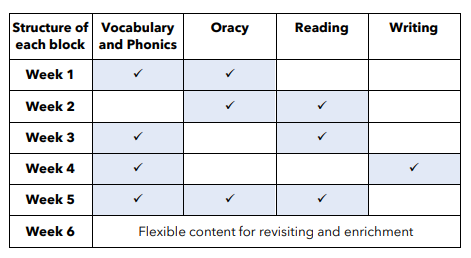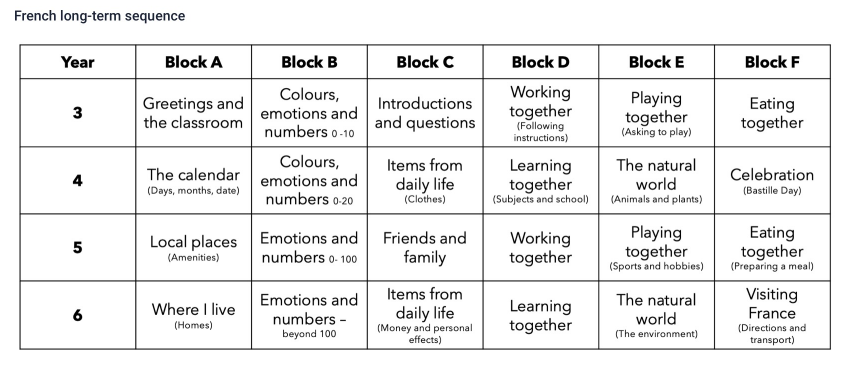French
What does French look like at South Wonston?
Intent
The purpose of learning any foreign language is to help make children more aware of other cultures and improve their understanding of the world around them. At South Wonston, we intend to enable children to express their ideas and thoughts in another language and respond to its speakers, through speech, actions and in writing. We strive to provide opportunities to communicate for practical, everyday purposes and to foster a love of language, providing the children with the foundation for learning further languages in the future.
At South Wonston, almost a third of our students are from service families and many will have lived abroad communicating with children from a wealth of nationalities. Learning a foreign language enables our children to communicate with their peers with confidence, and also builds awareness of different languages and of the barriers many of our children face in learning them. By the time children leave South Wonston, they will appreciate that France is our closest neighbour and that French is spoken around the world. They will be able to use simple vocabulary to make greetings, express opinions and ask questions. As they start Secondary School, we aim for our children to be ready to express themselves confidently and willingly in their new surroundings with their peers; we would like our children to continue to enjoy learning French after they leave South Wonston Primary School.
Implementation:
CUSP French is purposefully built around the principles of evidence-led practice. This is to ensure that there is a focus on high-quality development of children as linguists. Core areas of study are revisited throughout the curriculum. Each unit of study focuses on phonics, grammatical structures, reading, writing, oracy and vocabulary. CUSP French is both teacher facing and pupil facing, building consistency in how French is taught across South Wonston and ensuring that teachers, including those with no prior knowledge of French, have the subject knowledge required to teach the content. CUSP French serves young linguists in the modern world. Key areas of focus are selected to ensure that pupils are equipped with knowledge and language that will serve them in engaging with important and useful topics such as the environment, wellbeing and travel. The curriculum focuses not just on vocabulary acquisition but also on the building blocks of learning a new language. Clear structures and learning routines underpin CUSP French. This allows pupils (and teachers) to direct their cognitive attention to the core content in each block. Knowledge Notes are used to support instruction and the revisiting of new concepts. This strong focus on cognitive science provides the framework for pupils to deepen and broaden their knowledge of the French language and become confident, inspired linguists.
French is taught from Years 3 – 6. Each year group has 6 blocks of 5 weeks teaching. Additional weeks in the academic year can be used for consolidation, revisiting or enrichment. The curriculum is built to be delivered in 30 – 40 minutes of study per week. This can be organised as two shorter sessions (e.g. 2 x 15 – 20 minutes) or one longer lesson.


There is a significant focus on revisiting throughout the curriculum with the aim of pupils mastering key knowledge that can be built on as they move through the programme of study.
There is limited emphasis on pupils’ writing of French and a greater focus on reading, oracy and laying strong linguistic foundations. This is because pupils need to hear, see and say whole, correctly spelt words frequently before they are asked to apply these to written tasks. As pupils become more confident with curriculum content, teachers may choose to use the flexible content weeks to further develop pupils’ written French.
Teachers are encouraged to identify an appropriate entry point into the curriculum. The high-level of revisiting of both substantive and disciplinary knowledge ensures that pupils have multiple opportunities to consolidate learning. Where teachers need to start earlier in the curriculum than pupils’ current chronological starting points, they may choose to reduce the number of revisiting lessons later on to help pupils catch up over time.
Cultural development
The French curriculum has a strong focus on supporting pupils to meaningfully develop their understanding of other cultures and issues that impact on the wider global community. Therefore, there is a specific emphasis on teaching pupils about French customs, traditions and heritage, including those that are both similar or different to pupils’ own experiences of life in modern Britain. Significant French figures are introduced throughout the curriculum, as are notable French landmarks. Pupils will learn about the geography of France and its place within the wider world, including key trade exports and significant achievements of the French civilisation through history. This learning will be linked to pupils’ learning from the wider curriculum, for example, their study of significant artists or musicians.
Impact:
Knowledge notes and organisers give pupils a visual clue to help navigate and retain key knowledge taught in that lesson and consequent lessons. Every lesson provides cultural information about France which is essential for developing global awareness and pupils’ knowledge of cultures beyond their own. Pupils have the chance to see and hear key vocabulary explored in each lesson. Instruction of the vocabulary is supported through the use of dual coding and audio clips, to give an authentic French accent. Throughout KS2, pupils should be taught appropriate pronunciation, this includes instruction of the French phonics code which is crucial to gaining an understanding of the language as a whole and laying the foundations of learning for the future.
The strategy of ‘my turn’, ‘our turn’ and ‘your turn’ allows for modelling pronunciation and drawing attention to key concepts that pupils will already know. It allows them to practise and embed key content taught during the lesson, as well as applying their knowledge to reading, writing or speaking.
